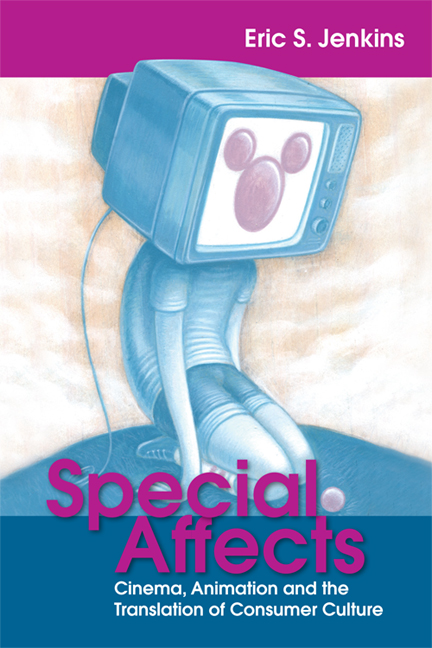Book contents
- Frontmatter
- Contents
- Acknowledgements
- List of Illustrations
- 1 Introduction
- 2 Astonishment and the Fantastic in Live-Action Cinema
- 3 Say Cheese! The Cinematic Lifestyle Consumer
- 4 Animation's Marvel and the Graphic Narrative Mode
- 5 Of Mice and Mimesis: The Wondrous Spark of Disney
- 6 Mutual Affection-Images and Daydreaming Consumers
- 7 The Disney Version of the American Dream
- 8 Walt and Wall-E in Control Society
- Movies Referenced in Special Affects
- Notes
- Index
5 - Of Mice and Mimesis: The Wondrous Spark of Disney
Published online by Cambridge University Press: 05 August 2016
- Frontmatter
- Contents
- Acknowledgements
- List of Illustrations
- 1 Introduction
- 2 Astonishment and the Fantastic in Live-Action Cinema
- 3 Say Cheese! The Cinematic Lifestyle Consumer
- 4 Animation's Marvel and the Graphic Narrative Mode
- 5 Of Mice and Mimesis: The Wondrous Spark of Disney
- 6 Mutual Affection-Images and Daydreaming Consumers
- 7 The Disney Version of the American Dream
- 8 Walt and Wall-E in Control Society
- Movies Referenced in Special Affects
- Notes
- Index
Summary
Before its release on 21 December 21 1937, Snow White was widely known as ‘Disney's folly’, both because of mounting costs (nearly 1.5 million dollars) and because many believed animation could never hold the audience's attention for the length of a feature. Sceptics insisted that audiences would never care enough for drawings in order to evoke the full range of emotions commonly experienced in live-action films. The marvel of animation seemed restricted to motion and, hence, the chases, gags, crashes and bangs of graphic narrative. Animation could be an art of motion, many thought, but not of life.
After release, Snow White was praised as a wonder, a masterpiece, declared a true breakthrough, something never seen before. Such responses stem from the experience of a different spark – not the marvel of the moving line but the wonder of life, and therefore the full range of emotions such as fear, sadness and joy that accompany life. In this chapter, we will see how this spark results from the mode of animistic mimesis, in which the folding occurs between the viewer's knowledge of non-existence and their sensation of life. In animistic mimesis, viewers perceive synchronised sounds and drawings as expressive, affective life. This perception is more about touch, about feeling, than about sight; hence the term mimesis. And it is the feeling of another life, both human and not; hence animistic.
Disney translated cinema and graphic narrative into animistic mimesis, drawing primarily on animation's transferability to formulate an economy between semblance (cinema) and play (animation). Disney created a world with semblances of ‘real’, cinematic space in order to feature the transformative play of animation, especially in privileged mutual-affection images that are frequently cited as the most emotional moments of the films. Transferability will be employed throughout Disney's features but most distinctly in these peak moments of animistic transformation, in which puppet becomes boy, maid becomes princess, and elephant becomes star. Transferring light, colour, sound and gesture between the layers enabled viewers to enter into those layers, to be affected via a mimetic communication that felt, in transition, like life (affect) and would be described as wonder (affection). In turn, this mode will result in a newly visible daydreaming consumer, uniquely impacting the course of (post)modern consumer culture.
- Type
- Chapter
- Information
- Special AffectsCinema, Animation and the Translation of Consumer Culture, pp. 110 - 138Publisher: Edinburgh University PressPrint publication year: 2014



